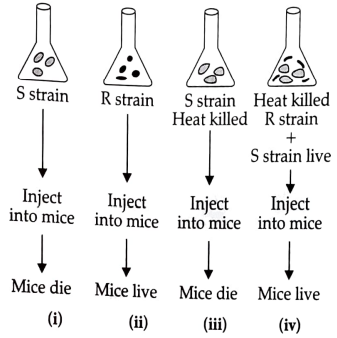Select Question Set:
Study the given diagrammatic representation of Griffith's experiment to demonstrate the transformation in bacteria.

Select the option which is incorrectly representing the experiment:
1. (i) and (ii)
2. (ii) and (iii)
3. (iii) and (iv)
4. (ii) and (iv)
Subtopic: Search for Genetic Material |
90%
From NCERT
Please attempt this question first.
Hints
Please attempt this question first.
| Assertion (A): | Primary transcripts in eukaryotes are non-functional. |
| Reason (R): | Methyl guanosine triphosphate is attached to 5' -end of hnRNA. |
| 1. | Both (A) and (R) are true and (R) is the correct explanation of (A). |
| 2. | Both (A) and (R) are true but (R) is not the correct explanation of (A). |
| 3. | (A) is true but (R) is false. |
| 4. | (A) is false but (R) is true. |
Subtopic: Transcription: IV |
66%
From NCERT
Please attempt this question first.
Hints
Please attempt this question first.
The length of DNA is:
1. Only I is correct
2. Only II is correct
3. Both I and II are correct
4. Both I and II are incorrect
| I: | usually defined as number of nucleotides (or a pair of nucleotide referred to as base pairs) present in it. |
| II: | is the characteristic of an organism. |
1. Only I is correct
2. Only II is correct
3. Both I and II are correct
4. Both I and II are incorrect
Subtopic: The DNA |
80%
From NCERT
Please attempt this question first.
Hints
Please attempt this question first.
Consider the given two statements:
| Statement I: | A nitrogenous base is linked to the OH of 1'C pentose sugar through a N-glycosidic linkage to form a nucleoside. |
| Statement II: | When a phosphate group is linked to OH of 5'C of a nucleoside through phosphoester linkage, a corresponding nucleotide (or deoxynucleotide depending upon the type of sugar present) is formed. |
| 1. | Statement I is correct; Statement II is incorrect |
| 2. | Statement I is incorrect; Statement II is incorrect |
| 3. | Statement I is correct; Statement II is correct |
| 4. | Statement I is incorrect; Statement II is correct |
Subtopic: The DNA |
88%
From NCERT
Please attempt this question first.
Hints
Please attempt this question first.
In the given diagram:

1. Only I and II are correct
2. Only II and III are correct
3. I, II and III are correct
4. I, II, and III are incorrect

| I: | A is 3’-5’ direction. |
| II: | B is hydrogen bond. |
| III: | C is phosphodiester bond. |
1. Only I and II are correct
2. Only II and III are correct
3. I, II and III are correct
4. I, II, and III are incorrect
Subtopic: DNA Double Helix |
66%
From NCERT
Please attempt this question first.
Hints
Please attempt this question first.
Deoxythymidine is:
| 1. | a substituted pyrimidine found only in DNA |
| 2. | a nucleoside monophosphate found only in DNA |
| 3. | a nucleoside found in DNA |
| 4. | a nucleotide formed by chemical modifications in a RNA nucleotide |
Subtopic: DNA Double Helix |
52%
From NCERT
Please attempt this question first.
Hints
Please attempt this question first.
When compared to DNA, in RNA:
1. Only I is correct
2. Only II is correct
3. Both I and II are correct
4. Both I and II are incorrect
| I: | every nucleotide residue has an additional –OH group present at 3'-position in the ribose. |
| II: | 5-methyl uracil is found instead of thymine. |
1. Only I is correct
2. Only II is correct
3. Both I and II are correct
4. Both I and II are incorrect
Subtopic: DNA vs RNA as Genetic Material |
From NCERT
Please attempt this question first.
Hints
Please attempt this question first.
In 1953, James Watson and Francis Crick, proposed a very simple but famous Double Helix model for the structure of DNA, based on the X-ray diffraction data produced by:
| 1. | Maurice Wilkins and Rosalind Franklin |
| 2. | Beadle and Tatum |
| 3. | Temin and Baltimore |
| 4. | Avery–MacLeod–McCarty |
Subtopic: DNA Double Helix |
94%
From NCERT
Please attempt this question first.
Hints
Please attempt this question first.
“For a double stranded DNA, the ratios between Adenine and Thymine and Guanine and Cytosine are constant and equals one” – this statement is known as:
1. Central dogma of molecular biology
2. Chargaff’s rule
3. Tetra-nucelotide hypothesis by Levene
4. Genetic equilibrium
1. Central dogma of molecular biology
2. Chargaff’s rule
3. Tetra-nucelotide hypothesis by Levene
4. Genetic equilibrium
Subtopic: DNA Double Helix |
95%
From NCERT
Please attempt this question first.
Hints
Please attempt this question first.
Consider the given two statements:
| Assertion (A): | If the sequence of bases in one strand of the dsDNA molecule is known then the sequence in other strand can be predicted. |
| Reason (R): | The base pairing in a dsDNA molecule is complementary to each other. |
| 1. | Both (A) and (R) are True but (R) does not correctly explain (A). |
| 2. | (A) is True but (R) is False. |
| 3. | (A) is False but (R) is True. |
| 4. | Both (A) and (R) are True and (R) correctly explains (A). |
Subtopic: DNA Double Helix |
87%
From NCERT
Please attempt this question first.
Hints
Please attempt this question first.
Select Question Set:






